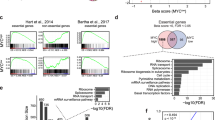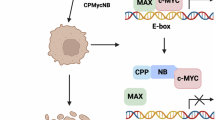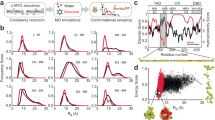Abstract
Thanatos-associated proteins (THAPs) are zinc-dependent, sequence-specific DNA-binding factors involved in cell proliferation, apoptosis, cell cycle, chromatin modification and transcriptional regulation. THAP11 is the most recently described member of this human protein family. In this study, we show that THAP11 is ubiquitously expressed in normal tissues and frequently downregulated in several human tumor tissues. Overexpression of THAP11 markedly inhibits growth of a number of different cells, including cancer cells and non-transformed cells. Silencing of THAP11 by RNA interference in HepG2 cells results in loss of cell growth repression. These results suggest that human THAP11 may be an endogenous physiologic regulator of cell proliferation. We also provide evidence that the function of THAP11 is mediated by its ability to repress transcription of c-Myc. Promoter reporter assays indicate a DNA binding-dependent c-Myc transcriptional repression. Chromatin immunoprecipitations and EMSA assay suggest that THAP11 directly binds to the c-Myc promoter. The findings that expression of c-Myc rescues significantly cells from THAP11-mediated cell growth suppression and that THAP11 expression only slightly inhibits c-Myc null fibroblasts cells growth reveal that THAP11 inhibits cell growth through downregulation of c-Myc expression. Taken together, these suggest that THAP11 functions as a cell growth suppressor by negatively regulating the expression of c-Myc.
Similar content being viewed by others
Log in or create a free account to read this content
Gain free access to this article, as well as selected content from this journal and more on nature.com
or
Accession codes
Abbreviations
- ChIP:
-
chromatin immunoprecipitation
- EMSA:
-
electrophoretic mobility shift assay
- GFP:
-
green fluorescence GFP
- HCC:
-
hepatocellular carcinoma
- ODC:
-
ornithin decarboxylase
- RNAi:
-
RNA interference
- RT-PCR:
-
reverse transcription-PCR
- THAP:
-
Thanatos-associated protein
References
Roussigne M, Kossida S, Lavigne AC, Clouaire T, Ecochard V, Glories A et al. The THAP domain: a novel protein motif with similarity to the DNA-binding domain of P element transposase. Trends Biochem Sci 2003; 28: 66–69.
Bhaskar V, Valentine SA, Courey AJ . A functional interaction between dorsal and components of the Smt3 conjugation machinery. J Biol Chem 2000; 275: 4033–4040.
Reddy KC, Villeneuve AM . C. elegans HIM-17 links chromatin modification and competence for initiation of meiotic recombination. Cell 2004; 118: 439–452.
Boxem M, van den Heuvel S . C. elegans class B synthetic multivulva genes act in G(1) regulation. Curr Biol 2002; 12: 906–911.
Fay DS, Keenan S, Han M . fzr-1 and lin-35/Rb function redundantly to control cell proliferation in C. elegans as revealed by a nonbiased synthetic screen. Genes Dev 2002; 16: 503–517.
Deiss LP, Feinstein E, Berissi H, Cohen O, Kimchi A . Identification of a novel serine/threonine kinase and a novel 15-kD protein as potential mediators of the gamma interferon-induced cell death. Genes Dev 1995; 9: 15–30.
Gale Jr M, Blakely CM, Hopkins DA, Melville MW, Wambach M, Romano PR et al. Regulation of interferon-induced protein kinase PKR: modulation of P58IPK inhibitory function by a novel protein, P52rIPK. Mol Cell Biol 1998; 18: 859–871.
Roussigne M, Cayrol C, Clouaire T, Amalric F, Girard JP . THAP1 is a nuclear proapoptotic factor that links prostate-apoptosis-response-4 (Par-4) to PML nuclear bodies. Oncogene 2003; 22: 2432–2442.
Clouaire T, Roussigne M, Ecochard V, Mathe C, Amalric F, Girard JP . The THAP domain of THAP1 is a large C2CH module with zinc-dependent sequence-specific DNA-binding activity. Proc Natl Acad Sci USA 2005; 102: 6907–6912.
Cayrol C, Lacroix C, Mathe C, Ecochard V, Ceribelli M, Loreau E et al. The THAP-zinc finger protein THAP1 regulates endothelial cell proliferation through modulation of pRB/E2F cell-cycle target genes. Blood 2007; 109: 584–594.
Macfarlan T, Kutney S, Altman B, Montross R, Yu J, Chakravarti D . Human THAP7 is a chromatin-associated, histone tail-binding protein that represses transcription via recruitment of HDAC3 and nuclear hormone receptor corepressor. J Biol Chem 2005; 280: 7346–7358.
Macfarlan T, Parker JB, Nagata K, Chakravarti D . Thanatos-associated protein 7 associates with template activating factor-Ibeta and inhibits histone acetylation to repress transcription. Mol Endocrinol 2006; 20: 335–347.
Pandey N, Mittal U, Srivastava AK, Mukerji M . SMARCA2 and THAP11: potential candidates for polyglutamine disorders as evidenced from polymorphism and protein-folding simulation studies. J Hum Genet 2004; 49: 596–602.
Dejosez M, Krumenacker JS, Zitur LJ, Passeri M, Chu LF, Songyang Z et al. Ronin is essential for embryogenesis and the pluripotency of mouse embryonic stem cells. Cell 2008; 133: 1162–1174.
Bouchard C, Staller P, Eilers M . Control of cell proliferation by Myc. Trends Cell Biol 1998; 8: 202–206.
Spencer CA, Groudine M . Control of c-myc regulation in normal and neoplastic cells. Adv Cancer Res 1991; 56: 1–48.
Daksis JI, Lu RY, Facchini LM, Marhin WW, Penn LJ . Myc induces cyclin D1 expression in the absence of de novo protein synthesis and links mitogen-stimulated signal transduction to the cell cycle. Oncogene 1994; 9: 3635–3645.
Yang W, Shen J, Wu M, Arsura M, FitzGerald M, Suldan Z et al. Repression of transcription of the p27(Kip1) cyclin-dependent kinase inhibitor gene by c-Myc. Oncogene 2001; 20: 1688–1702.
Claassen GF, Hann SR . A role for transcriptional repression of p21CIP1 by c-Myc in overcoming transforming growth factor beta -induced cell-cycle arrest. Proc Natl Acad Sci USA 2000; 97: 9498–9503.
Greasley PJ, Bonnard C, Amati B . Myc induces the nucleolin and BN51 genes: possible implications in ribosome biogenesis. Nucleic Acids Res 2000; 28: 446–453.
Bello-Fernandez C, Packham G, Cleveland JL . The ornithine decarboxylase gene is a transcriptional target of c-Myc. Proc Natl Acad Sci USA 1993; 90: 7804–7808.
Wu KJ, Grandori C, Amacker M, Simon-Vermot N, Polack A, Lingner J et al. Direct activation of TERT transcription by c-MYC. Nat Genet 1999; 21: 220–224.
Coller HA, Grandori C, Tamayo P, Colbert T, Lander ES, Eisenman RN et al. Expression analysis with oligonucleotide microarrays reveals that MYC regulates genes involved in growth, cell cycle, signaling, and adhesion. Proc Natl Acad Sci USA 2000; 97: 3260–3265.
Watson JD, Oster SK, Shago M, Khosravi F, Penn LZ . Identifying genes regulated in a Myc-dependent manner. J Biol Chem 2002; 277: 36921–36930.
Roy PG, Thompson AM . Cyclin D1 and breast cancer. Breast 2006; 15: 718–727.
Fong LY, Mancini R, Nakagawa H, Rustgi AK, Huebner K . Combined cyclin D1 overexpression and zinc deficiency disrupts cell cycle and accelerates mouse forestomach carcinogenesis. Cancer Res 2003; 63: 4244–4252.
Ginisty H, Sicard H, Roger B, Bouvet P . Structure and functions of nucleolin. J Cell Sci 1999; 112: 761–772.
Auvinen M, Jarvinen K, Hotti A, Okkeri J, Laitinen J, Janne OA et al. Transcriptional regulation of the ornithine decarboxylase gene by c-Myc/Max/Mad network and retinoblastoma protein interacting with c-Myc. Int J Biochem Cell Biol 2003; 35: 496–521.
Lan L, Trempus C, Gilmour SK . Inhibition of ornithine decarboxylase (ODC) decreases tumor vascularization and reverses spontaneous tumors in ODC/Ras transgenic mice. Cancer Res 2000; 60: 5696–5703.
Gartel AL, Serfas MS, Tyner AL . p21 – negative regulator of the cell cycle. Proc Soc Exp Biol Med 1996; 213: 138–149.
Carbone CJ, Grana X, Reddy EP, Haines DS . p21 loss cooperates with INK4 inactivation facilitating immortalization and Bcl-2-mediated anchorage-independent growth of oncogene-transduced primary mouse fibroblasts. Cancer Res 2007; 67: 4130–4137.
Filippova GN, Fagerlie S, Klenova EM, Myers C, Dehner Y, Goodwin G et al. An exceptionally conserved transcriptional repressor, CTCF, employs different combinations of zinc fingers to bind diverged promoter sequences of avian and mammalian c-myc oncogenes. Mol Cell Biol 1996; 16: 2802–2813.
Albert T, Wells J, Funk JO, Pullner A, Raschke EE, Stelzer G et al. The chromatin structure of the dual c-myc promoter P1/P2 is regulated by separate elements. J Biol Chem 2001; 276: 20482–20490.
Chaudhary D, Miller DM . The c-myc promoter binding protein (MBP-1) and TBP bind simultaneously in the minor groove of the c-myc P2 promoter. Biochemistry 1995; 34: 3438–3445.
Izzo MW, Strachan GD, Stubbs MC, Hall DJ . Transcriptional repression from the c-myc P2 promoter by the zinc finger protein ZF87/MAZ. J Biol Chem 1999; 274: 19498–19506.
Lin Y, Wong K, Calame K . Repression of c-myc transcription by Blimp-1, an inducer of terminal B cell differentiation. Science 1997; 276: 596–599.
Latil A, Cussenot O, Fournier G, Driouch K, Lidereau R . Loss of heterozygosity at chromosome 16q in prostate adenocarcinoma: identification of three independent regions. Cancer Res 1997; 57: 1058–1062.
Tsuda H, Zhang WD, Shimosato Y, Yokota J, Terada M, Sugimura T et al. Allele loss on chromosome 16 associated with progression of human hepatocellular carcinoma. Proc Natl Acad Sci USA 1990; 87: 6791–6794.
Marchong MN, Chen D, Corson TW, Lee C, Harmandayan M, Bowles E et al. Minimal 16q genomic loss implicates cadherin-11 in retinoblastoma. Mol Cancer Res 2004; 2: 495–503.
Filippova GN, Lindblom A, Meincke LJ, Klenova EM, Neiman PE, Collins SJ et al. A widely expressed transcription factor with multiple DNA sequence specificity, CTCF, is localized at chromosome segment 16q22.1 within one of the smallest regions of overlap for common deletions in breast and prostate cancers. Genes Chromosomes Cancer 1998; 22: 26–36.
Cartwright P, McLean C, Sheppard A, Rivett D, Jones K, Dalton S . LIF/STAT3 controls ES cell self-renewal and pluripotency by a Myc-dependent mechanism. Development 2005; 132: 885–896.
Sumi T, Tsuneyoshi N, Nakatsuji N, Suemori H . Apoptosis and differentiation of human embryonic stem cells induced by sustained activation of c-Myc. Oncogene 2007; 26: 5564–5576.
Mateyak MK, Obaya AJ, Adachi S, Sedivy JM . Phenotypes of c-Myc-deficient rat fibroblasts isolated by targeted homologous recombination. Cell Growth Differ 1997; 8: 1039–1048.
Eberhardy SR, D'Cunha CA, Farnham PJ . Direct examination of histone acetylation on Myc target genes using chromatin immunoprecipitation. J Biol Chem 2000; 275: 33798–33805.
Acknowledgements
We are grateful to Dr. Ken Kinzler and Bert Vogelstein (The Sidney Kimmel Comprehensive Cancer Center, Johns Hopkins University School of Medicine) for providing c-Myc promoter luciferase reporter, and appreciate Dr. Tong-Chuan He for advice. This work was partially supported by the Special Funds for Major State Basic Research of China (2006CB910802), Chinese National Natural Science Fund for the Popularization of Science (30321003), Chinese National Nature Foundation Key Program Project (30630035), Chinese National Natural Science Foundation project (30480659, 30870958), and Beijing National Natural Science Foundation project.
Author information
Authors and Affiliations
Corresponding author
Additional information
Edited by W EI-Deiry
Supplementary Information accompanies the paper on Cell Death and Differentiation website (http://www.nature.com/cdd)
Supplementary information
Rights and permissions
About this article
Cite this article
Zhu, CY., Li, CY., Li, Y. et al. Cell growth suppression by thanatos-associated protein 11(THAP11) is mediated by transcriptional downregulation of c-Myc. Cell Death Differ 16, 395–405 (2009). https://doi.org/10.1038/cdd.2008.160
Received:
Revised:
Accepted:
Published:
Issue date:
DOI: https://doi.org/10.1038/cdd.2008.160
Keywords
This article is cited by
-
The transcription factor CREB1 is a mechanistic driver of immunogenicity and reduced HIV-1 acquisition following ALVAC vaccination
Nature Immunology (2021)
-
Evolutionary-driven C-MYC gene expression in mammalian fibroblasts
Scientific Reports (2020)
-
ABRO1 suppresses tumourigenesis and regulates the DNA damage response by stabilizing p53
Nature Communications (2014)
-
NMR studies of a new family of DNA binding proteins: the THAP proteins
Journal of Biomolecular NMR (2013)
-
THAP proteins target specific DNA sites through bipartite recognition of adjacent major and minor grooves
Nature Structural & Molecular Biology (2010)



